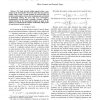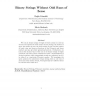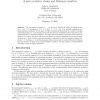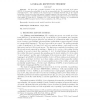98
Voted
CDC
2010
IEEE
14 years 7 months ago
2010
IEEE
We consider the problem of dynamic buying and selling of shares from a collection of N stocks with random price fluctuations. To limit investment risk, we place an upper bound on t...
106
click to vote
IPPS
2010
IEEE
14 years 10 months ago
2010
IEEE
We consider the problem of scheduling jobs on a pool of machines. Each job requires multiple machines on which it executes in parallel. For each job, the input specifies release ti...
108
Voted
TIT
2008
15 years 13 days ago
2008
Abstract-- We study network coding capacity under a constraint on the total number of network nodes that can perform coding. That is, only a certain number of network nodes can pro...
ARSCOM
2005
15 years 14 days ago
2005
We look at binary strings of length n which contain no odd run of zeros and express the total number of such strings, the number of zeros, the number of ones, the total number of ...
117
click to vote
ORDER
2008
15 years 15 days ago
2008
Given a poset P = (X, ), a partition X1, . . . , Xk of X is called an ordered partition of P if, whenever x Xi and y Xj with x y, then i j. In this paper, we show that for ever...
92
Voted
COMBINATORICS
2007
15 years 16 days ago
2007
We enumerate rooted triangulations of a sphere with multiple holes by the total number of edges and the length of each boundary component. The proof relies on a combinatorial iden...
111
Voted
COMCOM
2006
15 years 18 days ago
2006
One feature common to most existing routing protocols for wireless mobile ad hoc networks, or MANETs, is the need to flood control messages network-wide during the route acquisiti...
114
Voted
COMBINATORICS
2006
15 years 18 days ago
2006
We find the number of partitions of n whose BG-rank is j, in terms of pp(n), the number of pairs of partitions whose total number of cells is n, giving both bijective and generati...
DM
2008
15 years 19 days ago
2008
Fix nonnegative integers n1, . . . , nd and let L denote the lattice of integer points (a1, . . . , ad) Zd satisfying 0 ai ni for 1 i d. Let L be partially ordered by the usua...
101
Voted
STOC
1995
ACM
15 years 4 months ago
1995
ACM
We show that a parallel repetition of any two-prover one-round proof system (MIP(2, 1)) decreases the probability of error at an exponential rate. No constructive bound was previou...




